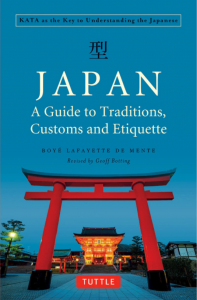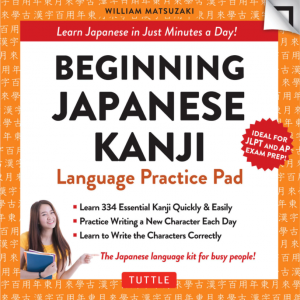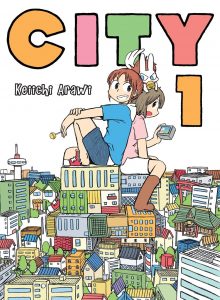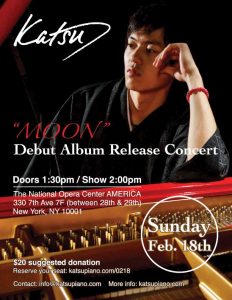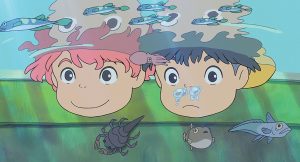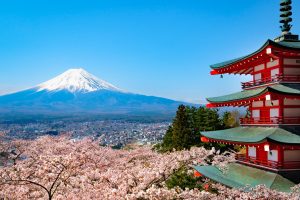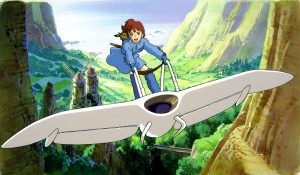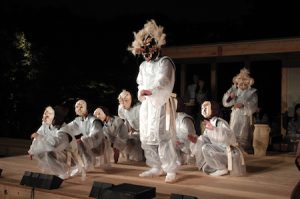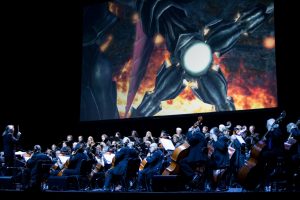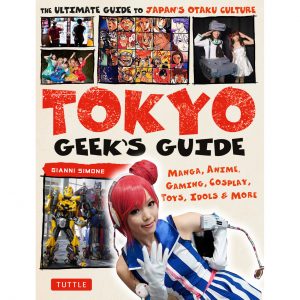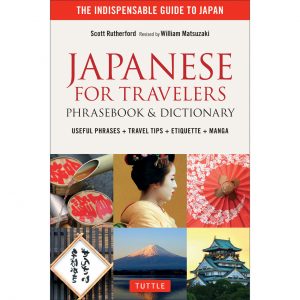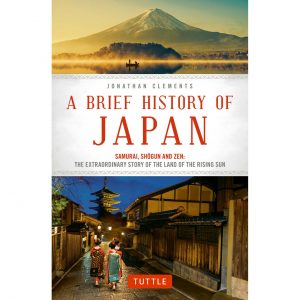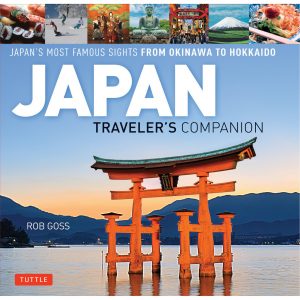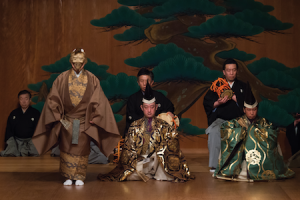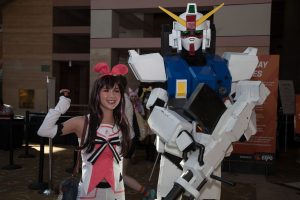JQ Magazine: Film Review — ‘Mary and the Witch’s Flower’
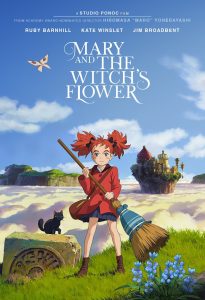
“Director Hiromasa Yonebayashi delivers a film packed with many of the attributes that characterizes Studio Ghibli at its best.” (Universal Pictures Home Entertainment)
By Lyle Sylvander (Yokohama–shi, 2001-02) for JQ magazine. Lyle has completed a master’s program at the School of International and Public Affairs at Columbia University and has been writing for the JET Alumni Association of New York since 2004. He is also the goalkeeper for FC Japan, a New York City–based soccer team.
Mary and the Witch’s Flower, the debut feature film from Studio Ponoc, an anime outfit founded by Studio Ghibli veterans Hiromasa Yonebayashi and Yoshiaki Nishimura after Ghibli closed its doors in 2015, starts in medias res, with a violent firestorm engulfing the screen. A small girl with bright red hair escapes the maelstrom by flying away on a broomstick, pursued by dolphin-squid-fighter-jet hybrids. She plunges down through the clouds and crashes into a field, where her stolen cargo of glowing blue flowers scatters, instantly transforming the landscape as trees burst out of the earth to towering heights in the blink of an eye. Who she is, where she is, and why she needs to escape isn’t revealed until the final act.
Director Yonebayashi delivers a film packed with many of the attributes that characterizes Studio Ghibli at its best. In this story (based on The Little Broomstick, a 1971 children’s novel by popular British author Mary Stewart, a young female protagonist journeys through a fantastical world, battling witches on a magical quest. As in the best films of Hayao Miyazaki, the hand-drawn animation (a novelty in the CGI-dominated marketplace) depicts a European fairy tale setting while retaining a unique Japanese otherworldliness. This family-friendly film recalls such Miyazaki masterworks as Howl’s Moving Castle, Spirited Away and Kiki’s Delivery Service. Unlike those films, however, Mary and the Witch’s Flower falls short of being a masterpiece.
The animators invoke worlds upon worlds here: the green woods and mist-filled forests of England rendered in swooning evocative watercolors, and the show-stopping Endor, a psychedelic space from out of a dream or drug trip, packed with strange objects, unexplainable phenomena, students floating by in soap bubbles, fountains morphing into human form, grotesque creatures loping out of the shrubbery, only to disappear just as quickly. Endor is dazzling in an off-putting way (similar to some of the “worlds” presented in Ari Folman’s The Congress, where animated avatars engulf their originals). The action sequences are intricate and thrilling.
JQ Magazine: JQ&A with Jazz Musician Meg Okura

“Japanese people are open and unafraid of owning music from other cultures. It’s a uniquely Japanese thing to embrace arts from other cultures and perform them at a high level.” (Taka Harkness)
By Allen Wan (Ishikawa-ken, 1990-92) for JQ magazine. Allen works as a foreign correspondent in Shanghai. He is also a lecturer in the executive MBA program at Jiao Tong University and currently serves as president of the Shanghai Foreign Correspondents Club. Allen would like to get in touch with other JET alumni in Shanghai who are interested in setting up a JETAA chapter.
Tokyo native Meg Okura defies convention. While forging a prolific career in music since graduating from Juilliard in the ’90s (working with the likes of Diana Krall and David Bowie to name a few), this Grammy-nominated jazz violinist continues reaching out to new audiences through her “world chamber jazz” that could mean anything from performing the erhu with her Pan Asian Chamber Jazz Ensemble or big band music from Japanese and Jewish composers.
As part of the NPO Trio, Okura recently released Live at the Stone, a collaboration with husband Sam Newsome (soprano saxophone) and Jean-Michel Pilc (piano) that creates a unique sound with hints of familiar melodies including well-known Yiddish songs and even excerpts of John Coltrane. Arriving May 13 is IMA IMA, Okura’s latest studio effort. A reflection on motherhood featuring the Pan Asian Chamber Jazz Ensemble and trumpeter Tom Harrell, this new material will be showcased in an intimate live performance at Dizzy’s Club Coca-Cola in New York on Aug. 20.
In this exclusive interview, Okura discusses her inspirations and also tackles taboo topics like whether the music industry needs its own #MeToo movement and the difficulty of making a living as a musical artist in the age of the internet.
You are known for your eclectic music, getting inspiration from jazz, pop, and all the way to 19th century Yiddish music. Is that a concerted effort to avoid being typecast in any particular genre?
I create music that is true to myself. Different types of music reveal themselves to me whether it sounds like Ose Shalom, J.S. Bach, Piazzolla, Coltrane or even YMO. I just welcome what comes to me. But don’t get me wrong, I am a firm proponent of straight-ahead jazz. I am a jazz musician first and foremost, but I also used to perform Brahms and Ravel, and have toured with Michael Brecker as well as many Jewish bands. So I just stay true to myself and try to accept my whole history and different life experiences.
Has being born and raised in Japan influenced your musical style? Why learn the erhu and not the shamisen, for instance?
Japanese people are open and unafraid of owning music from other cultures. For example, I am very unapologetic about learning the erhu, jazz, and Judaism—things that obviously belong to races, cultures, and traditions different from my own. It’s a uniquely Japanese thing to embrace arts from other cultures and perform them at a high level.
What got you hooked on Yiddish music, and did your husband have any influence on that?
Do you know that I have a big band called J-Orchestra? We play music by Jewish and Japanese composers including works by yours truly, who is both Jewish and Japanese. Not only am I a Jew but I have also studied German and Hebrew, so I always felt connected to the Yiddish melodies—minor melodies with major chords. I always cry every time I play “Oyfn Pripetchik.” My husband, Sam Newsome, on the other hand, is not Jewish. So he is not familiar with these melodies at all, and it works out beautifully keeping our music making fresh and unique.
JQ Magazine: Book Review — New from Tuttle (Spring 2018)
By Rashaad Jorden (Yamagata–ken, 2008-10) for JQ magazine. A former head of the JETAA Philadelphia Sub–Chapter, Rashaad is a graduate of Leeds Beckett University with a master’s degree in responsible tourism management. For more on his life abroad and enthusiasm for taiko drumming, visit his blog at www.gettingpounded.wordpress.com.
Tuttle Publishing has released another selection of Japan-related books, and the following quartet includes works that touch on Japanese etiquette, language study, Okinawan history, and picturesque Kyoto.
Japan: A Guide to Traditions, Customs and Etiquette
While studying Japanese, I learned the term shikata, which is translated as the “way of doing things.” However, as the late lecturer and writer Boyé Lafayette de Mente thoroughly documents, kata represents a lot more than a translation of “form”: It is a concept present in just about every aspect of Japanese society, whether it be the business world, poetry, or sumo. In essence, kata guides the country’s etiquette.
In Japan, the process of accomplishing a goal is just as significant, if not more significant, than the actual result—a notable contrast to the West. De Mente defines kata as the “way things are supposed to be done,” and he educates readers on how the concept has shaped Japan throughout its history and the present.
The author also touches on other cultural differences between Westerners and Japanese (such as communication styles) and people reading the book will probably nod their heads in agreement as they read certain passages, such as “Foreigners can live a lifetime in Japan and not fully understand how the Japanese system works the way it does” and why Japanese often express amazement at foreigners who can utter the simplest Japanese phrase. Japan: A Guide to Traditions, Customs and Etiquette is really an exploration of the Japanese psyche.
If nothing else, you’ll be amazing at how different Japan seems from the West.
Beginning Japanese Kanji: Language Practice Pad
Those seeking an introduction to kanji, or just a way to brush up on them, should turn to William Matsuzaki’s work. The pad is an excellent tool for busy people: The 334 kanji it presents lends itself to a simple, one kanji-a-day memorization for those aiming to study at a relaxed pace. Furthermore, each page contains terms utilizing the featured kanji and tips on how to write its strokes.
The kanji appearing in the pad is really nothing out of the ordinary, as you’ll see them in many (if not most) materials geared toward relatively novice Japanese learners. Adding to the book’s appeal, the inclusion of spaces to write the kanji (as well as sample sentences featuring the characters) is most useful for those looking to bolster their knowledge of the language.
JQ Magazine: Manga Review — ‘CITY’
By Rashaad Jorden (Yamagata–ken, 2008-10) for JQ magazine. A former head of the JETAA Philadelphia Sub–Chapter, Rashaad is a graduate of Leeds Beckett University with a master’s degree in responsible tourism management. For more on his life abroad and enthusiasm for taiko drumming, visit his blog at www.gettingpounded.wordpress.com.
Work often gets in the way of fun times. But if you incorporate some creativity into your life, that doesn’t have to be the case.
Enter the world of Midori Nagumo, the protagonist of the comedy manga CITY. In this first volume (which began serialization in Japan in September 2016) from creator Keiichi Arawi (Nichijou), Nagumo is a very broke college student whose landlady is constantly hounding her for money. Her roommate Niikura refuses to lend her money when she realizes what Nagumo’s true intention is.
Nagumo has to resort to other avenues to raise money, such as stealing a clay figure with the aim of selling it. But she clumsily drops the object, rendering it shattered. Crazily enough, immediately afterwards she’s offered a job at a restaurant (where the incident happens).
Our protagonist accepts the job but still has issues. It doesn’t help that her landlady has a police officer help “move” (or steal) all of her stuff so she wouldn’t escape (as the stolen items are actually collateral). In the middle of the volume, Nagumo reflects on her life, telling herself that if she could continue to have lots of happy moments, she’d be unbelievably thrilled with her life.
WIT Life #321: Sato Sakura Gallery
Written by professional Writer/Interpreter/Translator Stacy Smith (Kumamoto-ken CIR, 2000-03), WIT Life is a periodic series about aspects of Japanese culture such as language, film, business, food and politics. Stacy starts her day by watching Fujisankei’s newscast in Japanese, and here she shares some interesting tidbits and trends along with her own observations.
Last September, Chelsea received a great addition to its art scene in the form of the Sato Sakura Gallery. This Japan-born museum has two locations (Fukushima/Tokyo) that specialize in 日本画 (Nihon-ga or traditional Japanese painting). This term and concept was created in response to 西洋画 (Seiyou-ga or Western painting), which made its way to Japan during the Meiji Era (1868). Today the idea of Nihon-ga can refer to both purely traditional Japanese painting, as well as new styles of painting that incorporate Western painting methods while remaining faithful to traditional Japanese painting techniques.
The inaugural exhibit at the new Chelsea location has 桜 (sakura or cherry blossoms) as its theme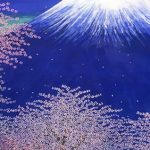 , and showcases 12 different artists and their works. They range from regular-sized paintings to giant folding screens, and my favorites were from self-proclaimed “flower and cherry blossom maniac” Reiji Hiramatsu. In particular, his work “Playful Carps” piece is impressive. Its bright colors are striking, and I enjoy the playfulness of the fish in a pond with petals filling its surface. I also really like his “Mt. Fuji and Cherry Blossoms,” Read More
, and showcases 12 different artists and their works. They range from regular-sized paintings to giant folding screens, and my favorites were from self-proclaimed “flower and cherry blossom maniac” Reiji Hiramatsu. In particular, his work “Playful Carps” piece is impressive. Its bright colors are striking, and I enjoy the playfulness of the fish in a pond with petals filling its surface. I also really like his “Mt. Fuji and Cherry Blossoms,” Read More
JQ Magazine: Nippon in New York – Hello from Japan, Katsu Album Release, ‘Ponyo’ Turns 10
By JQ magazine editor Justin Tedaldi (CIR Kobe–shi, 2001-02). Justin has written about Japanese arts and entertainment for JETAA since 2005. For more of his articles, click here.
Stay warm this winter with some hot local events, from live showcases that will transport you to another time and place, some new anime screenings, and a sake extravaganza you won’t want to miss.
Now through May 6
Children’s Museum of Manhattan, 212 West 83rd Street
$14 children/adults, $11 seniors
Experience Tokyo’s vibrant culture in a new interactive exhibit! Children will have fun learning about life in present day Japan in this playful, highly immersive environment that transports families to two distinct areas of Tokyo that exist side by side: one serene and exquisite, the other, too cute for words. Kawaii Central is a streetscape inspired by Tokyo’s bustling Harajuku district, bursting with color, trendy shops and cuter than cute styles. Kids sing karaoke, smile for the photo booth camera, serve up a seasonal Japanese meal, and design adorable mascots for their families. Plus, learn more about contemporary Japan through special programs for the public, free with admission.
Saturday, Feb. 3, 3:30 p.m.
Private Japanese Tea Ceremony Demonstration @ The Secret Kyoto Garden
Urasenke Chanoyu Center of New York, 153 East 69th Street
$35 advance, $39 day of event
Experience one of Japan’s oldest traditional tea ceremonies in a secret indoor Japanese garden hidden in the Upper East Side—led by a Tea Master of Urasenke! Join New York Adventure Club for a traditional Japanese tea ceremony demonstration in the style of Urasenke, one of the main schools of Japanese tea ceremony. Established in 1967 to promote the rich cultural tea tradition of Urasenke in New York City, the UCC is a private organization that teaches its members how to master this ancient tradition over the course of 10-15 years. This event also offers an opportunity to consume the best quality sweets and matcha green tea from Kyoto, the birthplace of Urasenke.
Katsu: Debut Album Release Concert
National Opera Center – OPERA America, 330 Seventh Avenue
$20 suggested donation
Katsu started to perform in public about a month after he started playing the piano when he was the age of 19 by self-learning. He also started composing originals soon after the beginning of the public performances. After performing several times in Japan, He moved to New York. Then in December 2016, he debuted as a composer and a pianist at the Steinway Hall. Now, he has been performing his original tunes as a solo pianist at multiple venues. His music is described as New Age music, classical, Jazz, romantic piano, and more. This intimate performance will feature selections from his recently released debut album, Moon.
March 25-26, 28
E-Walk 42nd Street 13, 247 West 42nd Street / Empire 25, 234 West 42nd Street
$12.50 all ages
For the kickoff of Studio Ghibli Fest 2018, From the legendary Studio Ghibli, creators of Spirited Away and My Neighbor Totoro, and Academy Award-winning director Hayao Miyazaki, comes a heartwarming family adventure. When Sosuke, a young boy who lives on a clifftop overlooking the sea, rescues a stranded goldfish named Ponyo, he discovers more than he bargained for. Ponyo is a curious, energetic young creature who yearns to be human, but even as she causes chaos around the house, her father, a powerful sorcerer, schemes to return Ponyo to the sea. Miyazaki’s breathtaking, imaginative world is brought to life with an all-star cast, featuring (on the March 25 and March 28 English-language screenings) the voices of Cate Blanchett, Matt Damon, Lily Tomlin, Liam Neeson, and more.
Monday, March 26, 7:30 p.m.
Japan Society, 333 East 47th Street
$15, $10 Japan Society members, seniors and students
This program is the 13th installment of Japan Society’s annual Play Reading Series, which introduces topical plays from up-and-coming playwrights in Japan to artists and audiences in the U.S. Written by Hideto Iwai, the winner of the prestigious Kishida Kunio Award for Drama, Manhood follows the twisted turns in the lives of four men as their boyish posse faces the harsh realities of adulthood and old age. Sarah Hughes, a New York local and emerging theater director, leads her gender swapped cast in this off-kilter depiction of Japanese “bro culture.” Playwright Iwai joins in a post-performance Q&A with the audience and director.
Friday, March 30, 6:30 p.m.
The Nippon Club, 145 West 57th Street
$10 (materials included), RSVP at jpcourse@jfny.org
Are you planning a trip to Japan in the near future? If so, this workshop is for you! Please join us for our Travel Japanese workshop and learn Japanese vocabulary and basic expressions essential for travel in Japan! Japanese customs and useful travel information will also be introduced. In this workshop, you will be able to order food at a restaurant using simple terms, communicate with a store attendant while doing shopping, tell your destination to a taxi driver or station agent and ask for information, and more!
Want to stay in the loop on future events? Follow Justin on Facebook and Twitter.
JQ Magazine: Theatre Review — ‘Mugen Noh Othello’
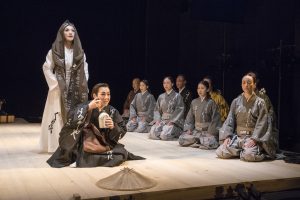
“In this striking setting, the noh theatrics perfectly capture and complement the emotions and thoughts recurring in Shakespeare’s play.” (Richard Termine)
By Lyle Sylvander (Yokohama–shi, 2001-02) for JQ magazine. Lyle has completed a master’s program at the School of International and Public Affairs at Columbia University and has been writing for the JET Alumni Association of New York since 2004. He is also the goalkeeper for FC Japan, a New York City–based soccer team.
From Jan. 11-14, director Satoshi Miyagi and his company Shizuoka Performing Arts Center (SPAC) returned to Japan Society of New York with their sold-out production of Mugen Noh Othello. As with their previous Madea (seen at Japan Society in 2011), Miyagi and company adapt a classic play from the Western canon and infuse it with the stylistic conventions of noh. Specifically, Miyagi and his playwright Sukehiro Hirakawa re-tell the story from the viewpoint of Desdemona’s ghost, a traditional in the mugen (supernatural) style of noh. This style typically involves otherworldly beings, including gods, spirits and ghosts. Time is often depicted as passing in a non-linear fashion, and action may switch between two or more timeframes from moment to moment, including flashbacks.
Noh theatre is considered to be the highest art form among the five classical Japanese forms of theatre: noh, kabuki, bunraku, butoh and kyogen. The art form requires highly trained actors and musicians (Mugen Noh Othello featured a percussion ensemble of six). The actors usually wear masks to signify the characters’ gender, age and social ranking, and by wearing masks the actors may portray youngsters, old men, female, or even nonhuman characters such as demons or animals. Noh also contains a uniquely structured stage with the hashigakari, a narrow bridge that is used for entering. Since Japan Society’s theater contains a more conventional stage (albeit without proscenium), the hashigakari has been approximated. All actors enter through it, as if entering from another space into the new shared theatrical space with the audience. Throughout the performance, the actors chant in unison, further accentuating the otherworldly atmosphere.
JQ Magazine: Nippon in New York — Studio Ghibli, ‘Final Fantasy’ @ 30, ‘Mary and the Witch’s Flower’
By JQ magazine editor Justin Tedaldi (CIR Kobe–shi, 2001-02). Justin has written about Japanese arts and entertainment for JETAA since 2005. For more of his articles, click here.
Start 2018 off right by heading down to your local concert hall, cinema, or arts center for some fantastic new year’s fare. Whether you enjoy movies, travel, or orchestral performances classic video games, treat yourself and catch a break from the cold.
This month’s highlights include:
Jan. 1-11
IFC Center, 323 Sixth Avenue
$15 adults, $11 children
In collaboration with GKIDS, IFC Center is pleased to present the return of this smash-hit retrospective of Japan’s famed Studio Ghibli animation house. Don’t miss your chance to see some of the greatest films of all time on the big screen! Titles include the favorites Spirited Away, Nausicaä and My Neighbor Totoro—with select screenings on 35mm prints! All films shown prior to 6 p.m. will be screened in the English-language version; evening shows will be subtitled in English. For a list of all films and dates, click here.
Jan. 11-14
Japan Society, 333 East 47th Street
$35, $30 Japan Society members
Following a sold-out run of Medea in 2011, Satoshi Miyagi and his company SPAC return to New York with another literary masterpiece, Othello. Miyagi re-tells Shakespeare’s famed tragedy through noh theater’s most distinct storytelling structure, mugen noh, or a play that features a spirit. Told from the perspective of Othello’s wife Desdemona, who returns as a ghost after her death, Miyagi’s production is replete with stunning masks and costumes as well as powerful live music and chanting. Performed in Japanese with English titles. The Friday, Jan. 12 performance is followed by an artist Q&A.
Saturday, Jan. 13, 2:00 p.m. and 8:00 p.m.
Distant Worlds: Music from Final Fantasy
Carnegie Hall (Stern Auditorium/Perelman Stage), 881 Seventh Avenue
$28-$120
Distant Worlds brings its concert production to one of the world’s most famous orchestral venues. With composer Nobuo Uematsu in attendance, the Distant Worlds Philharmonic Orchestra and the Dessoff Choirs under the direction of Grammy Award-winner Arnie Roth celebrate the 30th anniversary of Final Fantasy. These special performances feature exclusive HD video presentations from Square Enix alongside classic scores and new premieres.
JQ Magazine: Book Review — ‘Zen Gardens and Temples of Kyoto’
By Rashaad Jorden (Yamagata–ken, 2008-10) for JQ magazine. A former head of the JETAA Philadelphia Sub–Chapter, Rashaad is a graduate of Leeds Beckett University with a master’s degree in responsible tourism management. For more on his life abroad and enthusiasm for taiko drumming, visit his blog at www.gettingpounded.wordpress.com.
Kyoto has served as the focal point of Japanese cultural forms such as geisha, noh theater and ikebana. And as John Dougill thoroughly details in Zen Gardens and Temples of Kyoto, the city has played an enormous role in the development of Zen in Japan.
A professor at Kyoto’s largest Buddhist university, Dougill explores the ties between Japan’s former capital and the Buddhist sect in this guide to Kyoto’s most prominent Zen gardens and temple sites. While not the birthplace of Zen in Japan, Kyoto could be considered its soul as the city has long housed renowned temples where visitors and monks have sought serenity.
At first glance, such a book would seem to be a largely visual journal featuring a score of beautiful places. Zen Gardens doesn’t disappoint in that regard as photographer John Einarsen captures the splendor of some very spiritual places. But it’s clear early on that the book will rely primarily on stories to chronicle the story of Zen in Kyoto—not surprising since Dougill has previously written about Japan’s World Heritage Sites and Kyoto’s history.
JQ Magazine: Book Review — New from Tuttle (Fall 2017)
By Rashaad Jorden (Yamagata–ken, 2008-10) for JQ magazine. A former head of the JETAA Philadelphia Sub–Chapter, Rashaad is a graduate of Leeds Beckett University with a master’s degree in responsible tourism management. For more on his life abroad and enthusiasm for taiko drumming, visit his blog at www.gettingpounded.wordpress.com.
Tuttle Publishing has released a selection of four books touching on subjects such as otaku culture, language/cultural tips for travelers, Japanese history, and inspiration for prospective visitors to Japan.
Many people have probably developed an interest in Japan through a deep affection for anime and manga (among other things). And with Tokyo being the obvious center of Japanese pop culture, this guide created by Gianni Simone serves as the perfect tool for otaku freaks to find heaven.
Tokyo Geek’s Guide basically resembles a travel guide as it contains tidbits about where to explore otaku culture (such as bookshops, stores, events and even eateries—anime-themed ones are abundant in Tokyo). But you don’t have to be planning a trip to the capital to benefit from the book, though. Simone includes plenty of information pertaining to the history of manga, anime and video games in Japan.
Japanese for Travelers Phrasebook & Dictionary
At first glance, Scott Rutherford’s creation seems like a carbon copy of any other resource geared toward helping travelers avoid or limit communication miscues. And certainly, the book lists the standard customary helpful phrases for visitors to Japan trying to navigate the local hotels, airports, restaurants, etc.
But Japanese for Travelers provides plenty of useful advice about conducting good Japanese etiquette (e.g., what to do when invited to someone’s house) and culture (the section devoted to Japanese naming culture is interesting). Although the guide doesn’t intend to be the most thorough tool for language learners, it does include an English-Japanese glossary and numerous grammatical tips. And perhaps most importantly in this technologically reliant time, Rutherford dedicates a chapter to advising readers about how not to get tripped up by technology in Japan.
To many, the title of Jonathan Clements’s work would seem to be an absolute impossibility. Indeed, he uses that word in the preface to describe his task in telling a story that spans “millions of years.” But Clements settles on “specific moments of transformation” in eleven chapters that address periods of Japanese history ranging from the legend behind Japan’s formation to the “lost decades” that saw the country face a dwindling population and struggling economy.
While the information Clements provides at some points may be overwhelming, A Brief History of Japan does come to life through the collection of images appearing in the middle of the book (such as depictions of prominent figures and photos of landmarks).
Many, if not most, travel guides will feature an endless parade of “what to do and see” recommendations, and Rob Goss’s work is no different in a sense. But unlike some editions of Lonely Planet and Fodor’s, it’s clear when opening up Japan: Traveler’s Companion for the first time that the book will be anything but dry.
The subtitle appearing on its cover is “Japan’s most famous sights from Okinawa to Hokkaido,” but the inclusion of popular tourist destinations isn’t the reason to pick up the book. Amazingly beautiful colorful photos of the country’s most famous places will leave you speechless, and Goss includes helpful information for potential visitors about facets of Japanese life such as matsuri, cutting edge technology, and tradition.
For more information, visit www.tuttlepublishing.com.
For more JQ magazine book reviews, click here.
By JQ magazine editor Justin Tedaldi (CIR Kobe-shi, 2001-02). Justin has written about Japanese arts and entertainment for JETAA since 2005. For more of his articles, click here.
From the silver screen to the stage to J-pop, November is just as colorful as the autumn leaves drifting through the air. Add these live events to the mix and you’ve got an irresistibly epic rundown.
This month’s highlights include:
Now through Dec. 16
Yayoi Kusama: Festival of Life and Infinity Nets
David Zwirner Galleries, 525 and 533 West 19th Street and 34 East 69th Street
Free
Yayoi Kusama’s work has transcended some of the most important art movements of the second half of the twentieth century, including Pop Art and Minimalism. The exhibitions will feature sixty-six paintings from her iconic My Eternal Soul series, new large-scale flower sculptures, a polka-dotted environment, and two Infinity Mirror Rooms in the Chelsea locations, and a selection of new Infinity Nets paintings uptown. The celebrated Infinity Mirror Rooms invite the viewer to experience a sense of infinity through the play of reflections between the circular shapes of light and the surrounding mirrors. The Infinity Net paintings on view at the gallery’s uptown location are the latest works in a series begun in New York in the 1950s, when Abstract Expressionism was still the dominant style. These canvases embodied a radical departure, featuring minutely painted nets across monochrome backgrounds.
Nov. 3-5
Japan Society, 333 East 47th Street
$95, $75 Japan Society members, seniors and students (Nov. 4-5 only)
Part of Japan Society’s NOH-NOW series, celebrating its 110th anniversary! Hiroshi Sugimoto, acclaimed visual artist and traditional Japanese arts connoisseur, offers his most recent noh piece. In this new play, the ghost of revered 16th century tea master Sen-no-Rikyu appears to tell the story of his tragic death by forced suicide. Opening a door onto medieval Japan, the program begins with a tea ceremony by Sen So’oku, direct descendent of Sen-no-Rikyu, and features Japan’s top noh actors and musicians. Performed in Japanese with English titles.

Courtesy of Chopsticksny.com
Nov. 16-Dec. 3
SoHo Playhouse, 15 Vandam Street
$30
Universally funny and yet so very Japanese. Katsura Sunshine makes his highly-anticipated off-Broadway debut! As the world’s first bilingual rakugo-ka (a traditional Japanese comic storyteller), he is an international ambassador of this 400-year tradition. Fresh off 10 smash-hit performances in London’s West End, he will have a series of performances bringing his unique yet authentic rakugo to Off Broadway—in Japanese and English!
Nov. 17-19
Jacob K. Javits Convention Center, 655 West 34th Street
$35-$60; VIP passes also available
“Anime and manga have taken the world by storm. While New York City is the largest city in America, no focused event championing Japanese pop culture calls it home and with a population of eight million there’s a massive demand here,” says Peter Tatara, LeftField Media’s vice president of anime events. “Anime NYC will be a celebration of this community of fans and a platform for publishers and studios from both sides of the Pacific to be in front of the eyes of attendees, trendsetters, and people who aren’t yet familiar with the worlds of anime and manga. We’re looking forward to a vibrant, dedicated celebration of everything in Japan that’s nerdy and cool, in the media capital of the world!”
In this inaugural three-day celebration of Japanese animation powered by Crunchyroll, attendees will be able to view exclusive anime screenings and meet major guests courtesy of international animation and manga publishers; play the latest in Japanese gaming technology; chow down on Japanese delicacies and fusion cuisine; rock out to musical guests direct from Tokyo; and more! An estimated 20,000 fans are expected to attend, with special guests featuring the English-language cast of Sailor Moon Crystal for a panel screening; the U.S. premieres of the films Gundam Thunderbolt: Bandit Flower and Fullmetal Alchemist, and the NY Ramen Summit, featuring a discussion between famed ramen chefs from around the city.
JQ Magazine: New York Comic Con, ‘Porco Rosso,’ ‘The Legend of Zelda,’ Food Porn Party
By JQ magazine editor Justin Tedaldi (CIR Kobe–shi, 2001-02). Justin has written about Japanese arts and entertainment for JETAA since 2005. For more of his articles, click here.
The Japan-centric events of the month ahead promise to be as rich and full as autumn itself—brisk and colorful, with a dash of unpredictability.
This month’s highlights include:

Volume 1—FAIRY TAIL © Hiro MASHIMA / Kodansha Ltd.; Hiro Mashima—Photo courtesy of Kodansha Ltd.; Volume 61—FAIRY TAIL © Hiro MASHIMA / Kodansha Ltd.
Thursday, Oct. 5, 6:30 p.m.
Hiro Mashima: The Magical World of Fairy Tail
Japan Society, 333 East 47th Street
$30, $25 Japan Society members, seniors and students
Award-winning manga artist Hiro Mashima, known for his bestselling series Fairy Tail, comes to Japan Society for a special talk in conjunction with New York Comic Con. The epic fantasy series, which has sold over 60 million copies worldwide, follows the rambunctious wizard’s guild Fairy Tail through adventures in a stunning variety of settings, with a mind-boggling array of colorful characters. Mashima, also renowned for his long-running series Rave Master, joins us to discuss the works that have captured the imaginations of fans around the world. Moderated by Ben Applegate, director of the Kodansha Comics publishing team at Penguin Random House, and interpreted by Misaki Kido, marketing director at Kodansha Advanced Media. One lucky guest will win a surprise gift from Mashima-sensei at the event! Followed by a reception.
Oct. 5-8
Jacob K. Javits Convention Center, 655 West 34th Street
Limited tickets available
With a record attendance of more than 170,000 visitors last year, the East Coast’s biggest gathering for fans of comics, film, anime and manga, New York Comic Con returns with its biggest roster of Hollywood talent to date, and features exclusive screenings, gaming, cosplay photo ops, interactive booths by manga publishers including Vertical Comics and Kodansha Comics , and special guest appearances by manga artists Hiro Mashima (Fairy Tail) and Akira Himekawa (The Legend of Zelda)!
Friday, Oct. 6, 7:00 p.m.
Japan Society, 333 East 47th Street
$13, $10 seniors and students, $5 Japan Society members
Screening in 35mm! An ace fighter pilot and ex-member of the Italian Air Force during WWI is mysteriously cursed with a pig’s face. Disillusioned with humanity, he adopts the name Porco Rosso (“Crimson Pig”) and spends his time near the Adriatic Sea, drinking at a local bar and fighting off air pirates for cash. Famous for his unsurpassable flying skills, Porco draws the envy and antagonism of an American pilot who plots to take him down with the help of the fascist Italian police. This sixth film by Hayao Miyazaki is among the master animator’s most personal and underrated, highlighting his deep love for aviation and pacifist worldview within an action-adventure story perfect for adults and children alike.
Premieres Friday, Oct. 13
Metrograph, 7 Ludlow Street
$15
In her new documentary, Lana Wilson (After Tiller) takes us deep inside the life of another extreme altruist, Ittetsu Nemoto, a punk-rocker-turned-Buddhist priest who has worked small miracles in suicide prevention in his native Japan. Now facing the new challenge of fatherhood, as well as rapidly escalating health problems of his own, Nemoto must answer a crucial question—can he justify risking his own life to help others carry on with theirs? With astonishing access and artistry, The Departure captures one man’s wrenching decision between self-preservation and selflessness. Select screenings on Oct. 13 and 14 feature a special Q&A with the director.
Oct. 13-14, 7:30 p.m.
Japan Society, 333 East 47th Street
$35, $30 Japan Society members
Aesthetics of the past, present, East and West meld together in Italian director/choreographer Luca Veggetti’s Left–Right–Left, which explores the point of intersection between Japan’s 14th-century noh tradition and today’s efforts in dance. With leading Japanese butoh and contemporary dancers, esteemed noh musicians and a child noh actor reciting text from noh plays Okina and Hagoromo, this production offers a lens into the microcosm of humanity. Performed in English. The Oct. 13 performance is followed by a MetLife Meet–the–Artists Reception. The Oct. 14 performance is followed by an artist Q&A.
Oct. 13-14, 8:00 p.m.
92nd Street Y (Buttenwieser Hall), 1395 Lexington Avenue
$15-$29
Tap dancer Kazu Kumagai, known for his “powerful athletic technique combined with a riveting clarity” (2016 Bessie Outstanding Performer Award) channels his exceptional rhythmic artistry into the intensity of HEAR/HERE. The program includes a live jazz quartet and guest tappers, including legends Ted Louis Levy and Brenda Bufalino (2016 Bessie Award for Lifetime Achievement). This Dig Dance show is Kazu’s return to 92Y after a sell-out performance last season.
Wednesday, Oct. 18, 7:00 p.m.
The Nippon Club, 145 West 57th Street
$250, $200 members
A one-of-a-kind cultural experience! See Japanese Ozashiki culture in person with Geisha (Geiko and Maiko) from Nara, Japan. They will entertain visitors with their arts such as music, dance, conversations and traditional games while you enjoy Japanese food and sake. For RSVP and more info, call (212) 581-2223, or email info@nipponclub.org, attn: Mita, Uchikawa.
Friday, Oct. 20, 8:00 p.m.
The Legend of Zelda: Symphony of the Goddesses
United Palace Theater, 4140 Broadway
$28.13-$120
Back by popular demand and presented by Jason Michael Paul Productions, The Legend of Zelda: Symphony of the Goddesses returns to New York with breathtakingly new visuals and music exploring additional chapters from the Zelda franchise as well as the beautifully orchestrated two-act symphony recounting the classic storylines from some of the most popular video games in history. Take up your wooden sword and shield as a live orchestra and the Montclair State University Vocal Accord brings to life the masterpieces of legendary Nintendo composer and sound director Koji Kondo.
Oct. 20-Nov. 17 (first rotation); Nov. 21-Jan. 7 (second rotation)
Hiroshi Sugimoto: Gates of Paradise
Japan Society, 333 East 47th Street
Single visit: $12/$10 students and seniors; both rotations: $20/$16 students and seniors;
free for Japan Society members; free admission on Fridays from 6:00 p.m.-9:00 p.m.
This fall, explore one of the earliest, and largely unknown, encounters between Japan and the West in the 16th century, as seen through the eyes of artist Hiroshi Sugimoto. In celebration of Japan Society’s 110th anniversary, Hiroshi Sugimoto: Gates of Paradise charts the story of four Japanese boys, who were swept up in the tide of religion, commerce and politics during the first Global Age and sent to the princely and papal courts of Europe. Journey in their footsteps through Sugimoto’s new monumental photographs of the sites they visited, and navigate the germination of cultural exchange between East and West with classical masterpieces of visually hybrid (nanban) art from Japanese and American collections. Join guests for the Escape East @333 happy hours on Oct. 20 and Nov. 10 at 6:00 p.m.

Courtesy of USA.kinokuniya.com
Saturday, Oct. 21, 2:00 p.m.
Tatsuya Miyanishi: Tyrannosaurus series
1073 Sixth Avenue
Acclaimed Japanese children’s author and illustrator Tatsuya Miyanishi will visit the U.S. for the first time this month! His Tyrannosaurus series consists of 12 titles and has sold more than 3 million copies in Japan, China, Korea, Taiwan, and France. There are four titles available in English so far from Museyon. Bring your kids to a nearby Kinokuniya Book Store (other cities including Edgewater, NJ are listed in the photo here) between October 21st and 29th for a presentation and book signing! Miyanishi is an entertaining presenter who will draw, read from his books, and discuss his work. A book signing will follow each presentation.
Saturday, Oct. 21, 7:00 p.m.
The Food Porn Party featuring Tampopo
AMC Empire 25, 234 West 42nd Street
$95, $125 VIP (use code “RESOBOX” for 10% off tickets)
Taste what you see on the screen! The Food Film Festival specializes in creating multisensory food and film experiences. At their events, guests watch films about food and simultaneously taste the exact dishes they see on the screen…right in their seats! Hosting their “Food Porn” Party featuring the cult classic film, Tampopo. Following the film, they are inviting everyone to join their Japanese Noodle Fest! Directed by Jûzô Itami, the tale of an enigmatic band of ramen ronin who guide the widow of a noodle shop owner on her quest for the perfect recipe, Tampopo serves up a savory broth of culinary adventure seasoned with offbeat comedy sketches and the erotic exploits of a gastronome gangster. Sweet, sexy, surreal, and mouthwatering, Tampopo remains one of the most delectable examples of food on film. Following the movie, there will be a Japanese noodle feast featuring ramen and more ramen, decadent dishes, cocktails, craft beer and more! Additional Food Film Festival events include James Beard: America’s First Foodie (Oct. 19), Hometown Heros: The Legend of the Chopped Cheese (Oct. 20), and For the Love of Brunch (Oct. 22). For a complete listing, click here.
Friday, Oct. 27, 11:30 a.m.-9:30 p.m.
NYC Event Spaces, 4 West 43rd Street
$35-$75
Chopsticks NY magazine presents its very first Sake and Food event, “Eat Up! Drink Up! Japan” on Oct. 27. During the event, we will divide Japan into six regional blocks and offer craft sake from each block and matching food made with the regional delicacies. Participants can appreciate sake from nationwide Japan and feel the sense of “terroir” in Japan. 18 dishes from nationwide, 3 from each block, will be served during the event. Every dish is crafted to be paired with regional sake. There will be at least one vegetarian dish in each block. Over 30 brands of sake, at least five brands for each region, will be served along with the dishes above. This event is 21 and over.
Saturday, Oct. 28, 6:30 p.m.
Ages of Enchantment: JPA Cultural Repertoires 2017
Symphony Space (Peter Jay Sharp Theater), 2537 Broadway
$30; $25 members; $18 seniors, students and children; $40 day of show
JPA returns for its first show in two years! This year’s performance consists of three categories: 1) Kimono show, 2) traditional Japanese dances, and 3) Japanese folk performing arts (from three regions). During the kimono show, five major kimono types will be shown with different craftsmanship with live models. The details of handcrafted fabric weaving, coloring, and decorating techniques will be explained, so when the audiences actually see the real kimono display, it can promote better learning experiences. After the kimono show, five pieces of traditional Japanese dance will be shown as the second section. The first piece is titled as the “Duet,” which is a rare parallel performance of Japanese traditional dance and Western ballet. The piece will display the differences between the two dance movements and the body uses by the dancers, so the audiences will be able to see the unique characteristics of Japanese dance much easier. The body use will be explained in the context of the cultural characteristics as well.
Oct. 29-Nov. 1
Various locations
$12.50-$13.50
Hayao Miyazaki’s Academy Award-winning masterpiece Spirited Away was the biggest box office hit of all time in Japan and helped redefine the possibilities of animation for American audiences and a generation of new filmmakers. Chihiro thinks she is on another boring trip with her parents. But when they stop at a village that is not all that it seems, her parents undergo a mysterious transformation, and Chihiro is whisked into a world of fantastic spirits, shape-shifting dragons and a witch who never wants to see her leave. She must call on the courage she never knew she had to free herself and return her family to the outside world.
Combining Japanese mythology with Alice in Wonderland-type whimsy, Spirited Away cemented Miyazaki’s reputation as an icon of animation and storytelling. The English-dubbed cast includes the vocal talents of Daveigh Chase, Jason Marsden, Suzanne Pleshette, David Ogden Stiers, Susan Egan, Tara Strong and more! Dubbed in English on Oct. 29 and November 1 and subtitled on Oct. 30, this special three–day event will also feature GKIDS Mini–Fest, an ongoing festival of the best animated shorts from around the world.
Want to stay in the loop on future events? Follow Justin on Facebook and Twitter.
JQ Magazine: Film Review — ‘The Red Turtle’
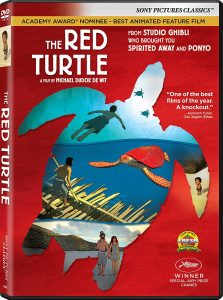
A critical analysis couched in fiction of the Academy Award-nominated Studio Ghibli co-production (Sony Pictures Classics)
By Preston Hatfield (Yamanashi-ken, 2009-10) for JQ magazine. Preston is the English teacher you wish you had growing up. He taught in Kofu, Yamanashi on JET and later received his Master’s in Education and teaching credential from Stanford University. He now teaches English at a public high school in the Silicon Valley, and is inspiring the leaders of tomorrow one dank meme at a time.
TL;DR: Directed by Dutch animator Michaël Dudok de Wit, The Red Turtle is another visual masterpiece by Studio Ghibli (making its external co–production debut here collaborating with a European team) with a unique artistic style that makes the scenery itself a prominent character. Though it lost me in parts, the story is poignant and evokes an array of feelings, few of which are pleasant, though nonetheless life–affirming. In order to fully appreciate this film (which has no dialogue), you need to be in a calm, patient, and cerebral mood. Also, make sure you watch it in a very dark room, as the film features numerous nighttime scenes that are hard to see with extra light.
You never asked from whence I came, if I had a family in my own land, if I was happy in my new life. I suppose you found those details immaterial as far as we were concerned, but you should know that from the moment I opened my eyes and coughed the seawater from my lungs on that accursed beach we called home, after surveying the island high and low, near and far, and discovering no human civilization from which I could find salvation, I devoted every precious calorie in my body to escaping that forsaken rock, ocean be damned.
Let my words carry across time and space; to echo across the sky and go bounding beyond the reach of the island that tethered me. Let me communicate what I couldn’t before. Let my memory endure, because I have lost everything else. Let me go.
I’ll never forget the first time I saw you, a scarlet leviathan that decimated my rafts like waves over sandcastles. I admit I never quite worked it out. Was it your will or the island’s that kept me from leaving? Who did I enrage so with my escape plan and headstrong persistence in the face of constant setback? I guess what I’m asking is, were you the warden of the prison, or just one of the guards? There in the open ocean I gazed at you, awe-struck, sure in that moment that you were going to kill me for being so daring.
JQ Magazine: Film Review — ‘Hayao Miyazaki: Never-Ending Man’

“This tight, 70-minute documentary does not wander. It preserves a feeling of deliberate pacing and purpose through clever editing, and possibly even some deliberate misdirection, which echo Miyazaki’s personal deliberations.” (© NHK)
By Greg Beck (Hiroshima–ken, 2006-11) for JQ magazine. Greg is a writer, producer, home brewer, and Social Coordinator for JETAA Southern California and Arizona. A former news producer for Tokyo Broadcasting System in New York, he currently works freelance in Los Angeles. For more cinema reviews, follow him on Twitter at @CIRBECK #MovieReview.
Receiving its East Coast premiere last night at Japan Society in New York, NHK’s new documentary on Studio Ghibli’s famed animation director Hayao Miyazaki offers a seemingly deep and undeniably personal look into the man’s current life, as well as his achievements and challenges, both artistically and—in his old age—existentially. True to Japanese-style filmmaking, we see a series of scenes as they happen, and are left to draw our own meaning. Still, this tight, 70-minute documentary does not wander. It preserves a feeling of deliberate pacing and purpose through clever editing, and possibly even some deliberate misdirection, which echo Miyazaki’s personal deliberations.
The film starts with Miyazaki’s retirement announcement at a press conference in September 2013. It then jumps forward two years, to an unseen and seldom-heard cameraman, whose perspective we take for this fly-on-the-wall documentary. Entering his gorgeous, countryside atelier, Miyazaki grumbles humbly, “What do you have a camera for? There’s nothing worth seeing. I’m retired.” He feeds birds, smokes, makes tea, and gripes about the complacency of Disney’s Frozen anthem “Let It Go,” but in no time shows that his creative drive is undiminished. Walking to a table covered in a pile of pages of new projects and material, he insists, “I’m a retired pensioner. I’m just fooling around now.” Read More
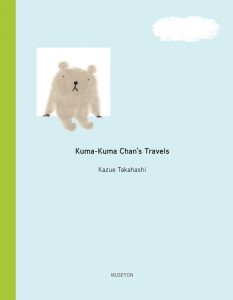
“Takahashi’s warm watercolors and relatable stories are guaranteed to entertain readers of all ages, and the latest English-language addition to this series, Kuma-Kuma Chan’s Travels, is every bit as enjoyable as its two predecessors.” (Museyon)
By Stacy Smith (Kumamoto-ken CIR, 2000-03) for JQ magazine. Stacy is a New York City–based provider of top quality Japanese interpreting, translating and writing/editing services. Starting from her initial encounter with Japan in her teens, she has built up a consummate understanding of the country‘s language and culture, enabling her to seamlessly traverse between Japan and the U.S. and serve as a bridge between the two. For more information, visit www.stacysmith.webs.com. As a writer, Stacy also shares tidbits and trends with her own observations in the periodic series WIT Life.
Having spent three years on JET in Kumamoto, home of nationwide sensation Kumamon who didn’t yet exist when I was there, I must honestly say that I approach bear characters with slight trepidation. However, I was delightfully surprised to love every minute of my encounter with Kuma-Kuma Chan, the bear who stars in the eponymous children’s book series written and illustrated by Kazue Takahashi. Her warm watercolors and relatable stories are guaranteed to entertain readers of all ages, and the latest English-language addition to this series, Kuma-Kuma Chan’s Travels, is every bit as enjoyable as its two predecessors.
The previous two books, Kuma-Kuma Chan, the Little Bear (previously reviewed in JQ here) and Kuma-Kuma Chan’s Home, looked at a day in the life of Kuma-Kuma Chan on his own and when a friend comes to visit. Kuma–Kuma Chan’s Travels is a bit more expansive, introducing readers to his world when he takes trips. I love the details at the beginning sharing what he brings with him on his journeys, along with accompanying illustrations such as a Thermos containing hot coffee. We later see him on top of a mountain drinking said coffee while watching the sunrise. These trips take place inside his head, but the descriptive text and beautiful pictures make you feel like you are with him everywhere he goes.
The series as a whole features a strong element of kawaii, or cuteness, which contributes to its Japaneseness. Also, there is an intangible sensibility to the stories that make them feel a bit different than traditional Western children’s books. In the inaugural Kuma–Kuma Chan, the Little Bear, we learn about his daily routine, which includes aspects such as eating a big salad for breakfast with lettuce from his garden and personal grooming like trimming his nails and hair. I particularly liked the scene which shows him during the winter, rolling around to catch the sunlight as the day progresses with the kerosene heater nearby. For many JET alumni, I’m sure this scene will be reminiscent of days spent in school offices where this was the sole source of heat.
For readers seeking a creature of a different nature, the Tyrannosaurus children’s books written and illustrated by Tatsuya Miyanishi is another series worth checking out. It currently features 13 titles, four of which have been published in the U.S. For those who would like to learn about these books and meet the acclaimed author, he will be at the New York and New Jersey locations of Books Kinokuniya at 2 p.m. on October 21 and 22, respectively. On both days, Miyanishi will be reading from and discussing his works, as well as signing books for those with purchased copies. For more dates in Texas, Washington and California, click here.
Kuma-Kuma Chan’s Travels is available October 1. For more information, click here.
For more JQ magazine book reviews, click here.

